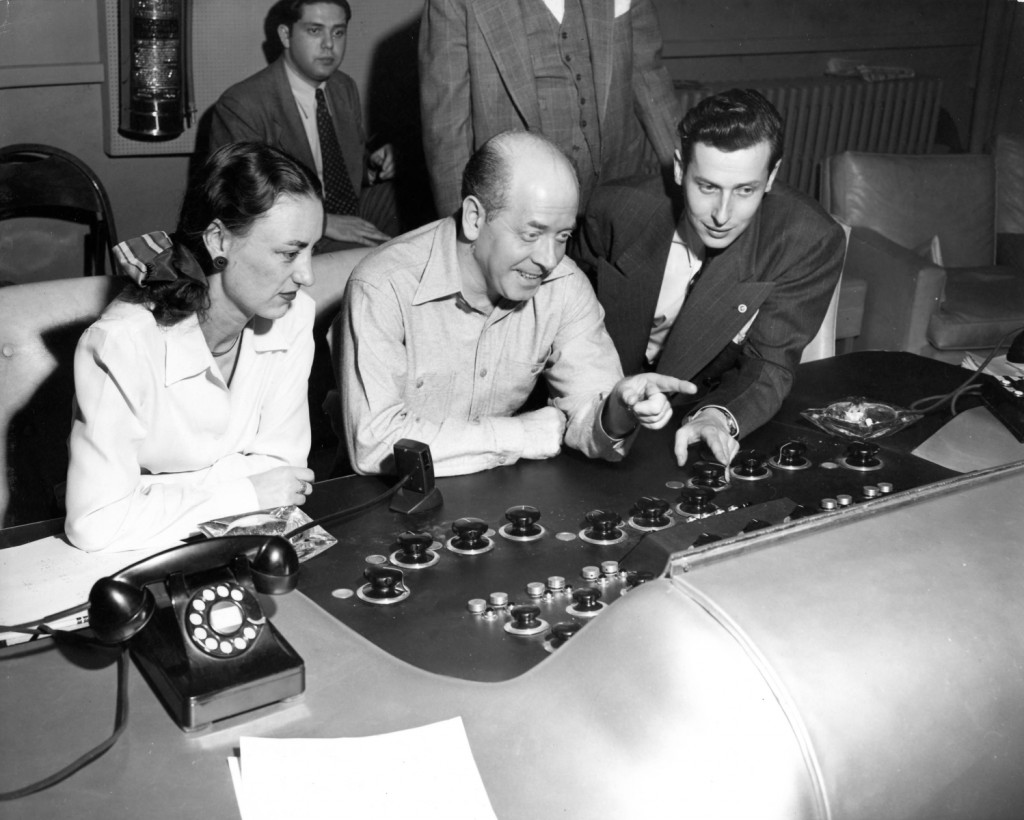 Above: Reeves studio A during music scoring for “Louisiana Story,” a 1949 Oscar nominee for Best Writing, Motion Picture Story. The soundtrack score, composed by Virgil Thomson, won a Pulitzer Prize. L to R: co-director Frances Flaherty, conductor Eugene Ormandy, and C. Robert Fine, mixing engineer. (Source: T. Fine)
Above: Reeves studio A during music scoring for “Louisiana Story,” a 1949 Oscar nominee for Best Writing, Motion Picture Story. The soundtrack score, composed by Virgil Thomson, won a Pulitzer Prize. L to R: co-director Frances Flaherty, conductor Eugene Ormandy, and C. Robert Fine, mixing engineer. (Source: T. Fine)
Considering that owner Hazard Reeves was the man responsible for introducing the magnetic soundtrack channel to motion-picture film, as well as being one of the developers of Cinerama, which prefigured both the stereo hi-fi music revolution and the IMAX film-format, there is surprisingly little information online regarding his Reeves Sound Studios (hf. RSS). RSS was in operation from approx. 1933 – 1980, and although it was primarily a sound-for-picture facility, some important albums were cut there, including early efforts by Thelonius Monk, Charlie Parker, and John Coltrane.
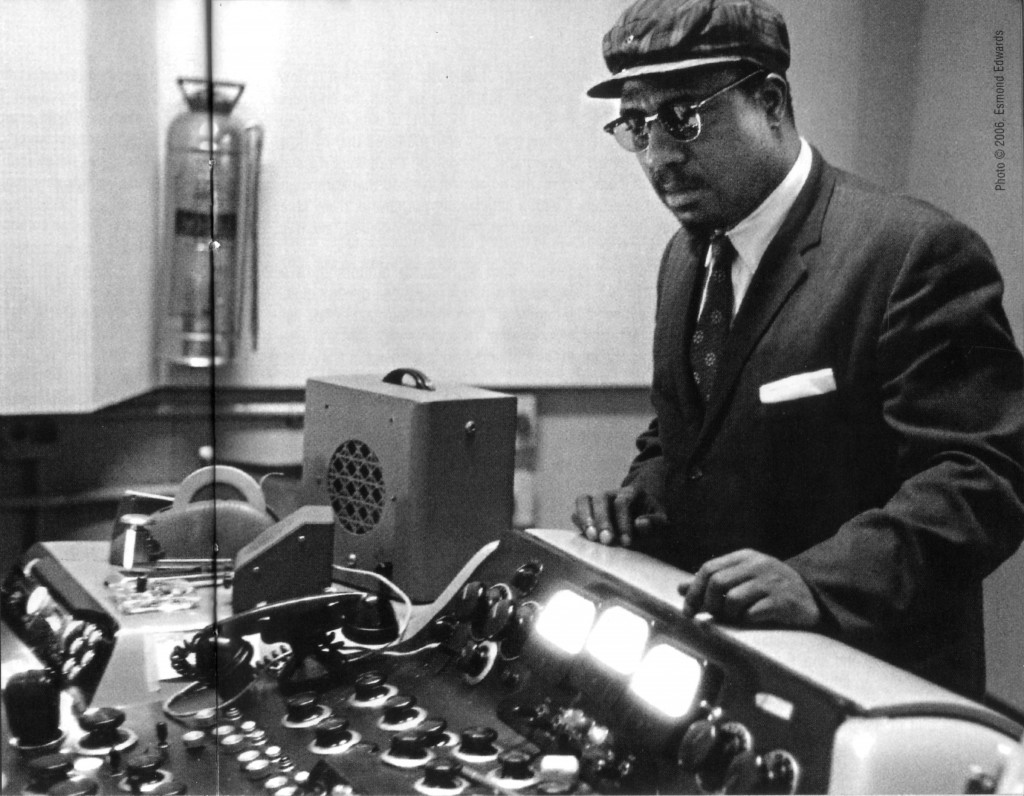 Monk listens to playback at Reeves c. 1956. Photo by E. Edwards.
Monk listens to playback at Reeves c. 1956. Photo by E. Edwards.
PS dot com contributor T. Fine has provided some background on this important piece of recording history. If any readers worked at RSS during its long history, please get in touch and tell us about it.
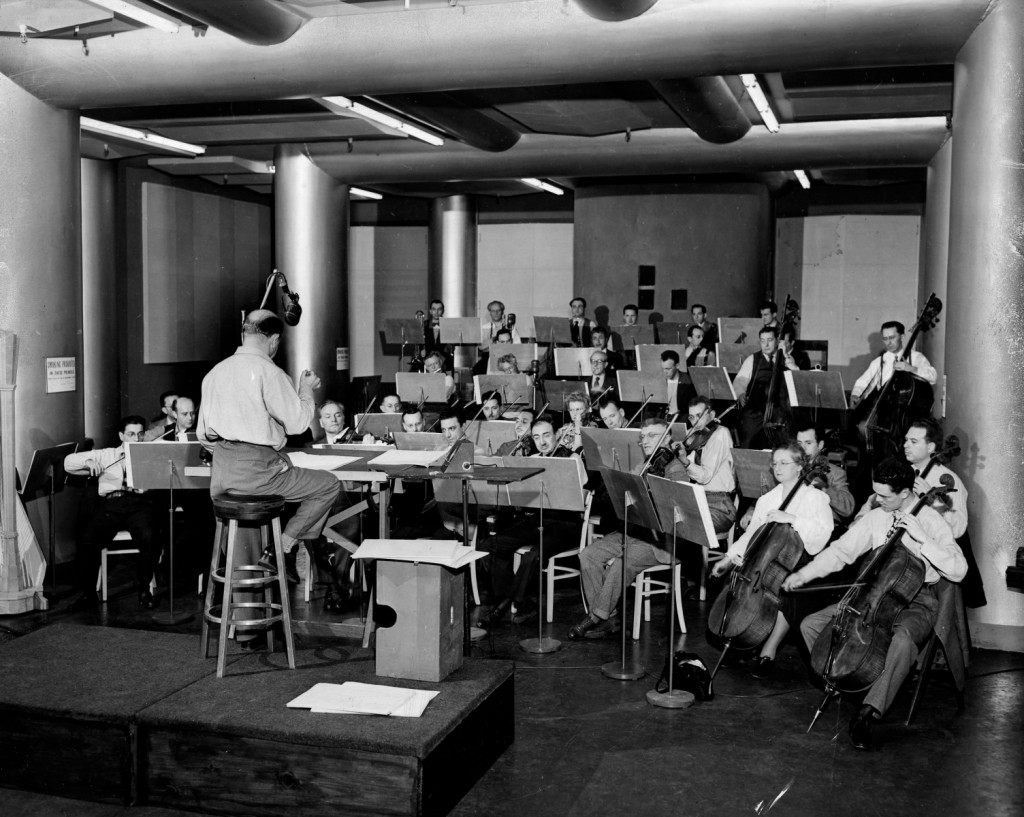 Above: soundtrack recording session for “Louisiana Story” in 1948. Eugene Ormandy is conducting the orchestra, with pickup via Altec 639 “Birdcage” microphones. (Source: T. Fine)
Above: soundtrack recording session for “Louisiana Story” in 1948. Eugene Ormandy is conducting the orchestra, with pickup via Altec 639 “Birdcage” microphones. (Source: T. Fine)
RSS opened its doors in 1933 (source: NYT). The earliest detailed account we have of its actual operation is a 1949 article by one Leon A. Wortman.
Click here to download a PDF of the article: Wortman-Fairchild_Studio_Design-low
Wortman’s piece(s) was originally published in the trade publication “FM AND TELEVISION” and subsequently re-published for promotional use by the Fairchild Recording Equipment Corporation. T. Fine: “Reeves (Sound Studios) was full of Fairchild and Langevin gear. Buzz Reeves was good friends with Sherman Fairchild.”
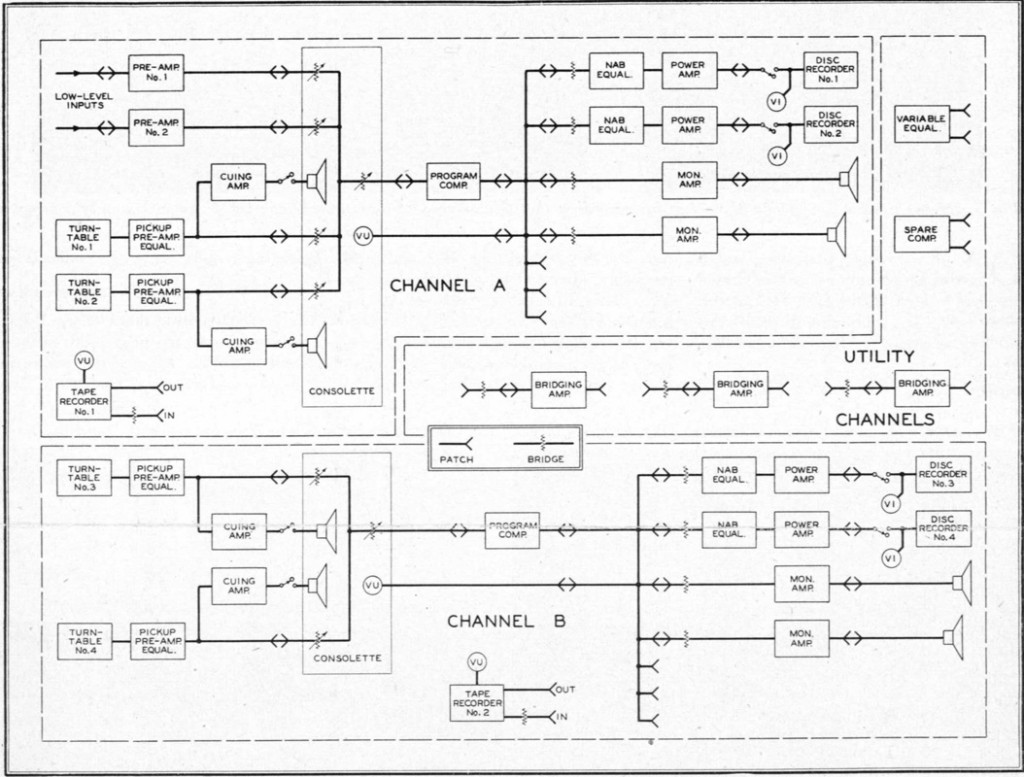 Above: schematic for RSS circa 1949 (Wortman)
Above: schematic for RSS circa 1949 (Wortman)
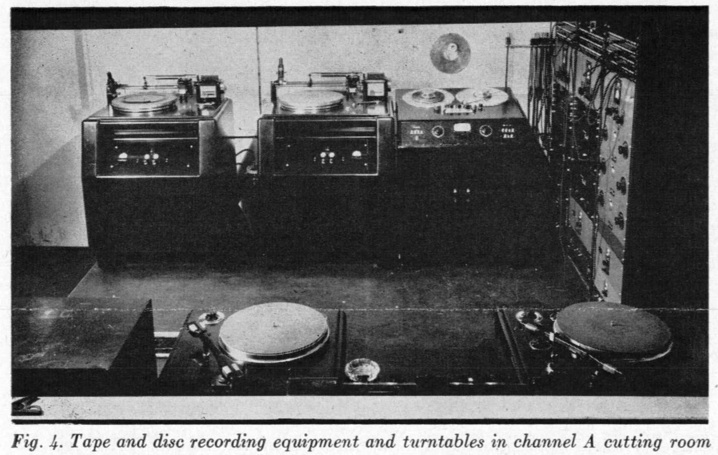
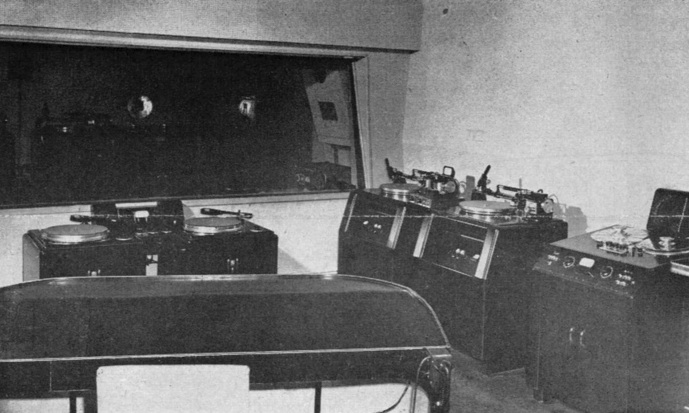 Reeves’ Room B c. 1949 (both above from Wortman)
Reeves’ Room B c. 1949 (both above from Wortman)
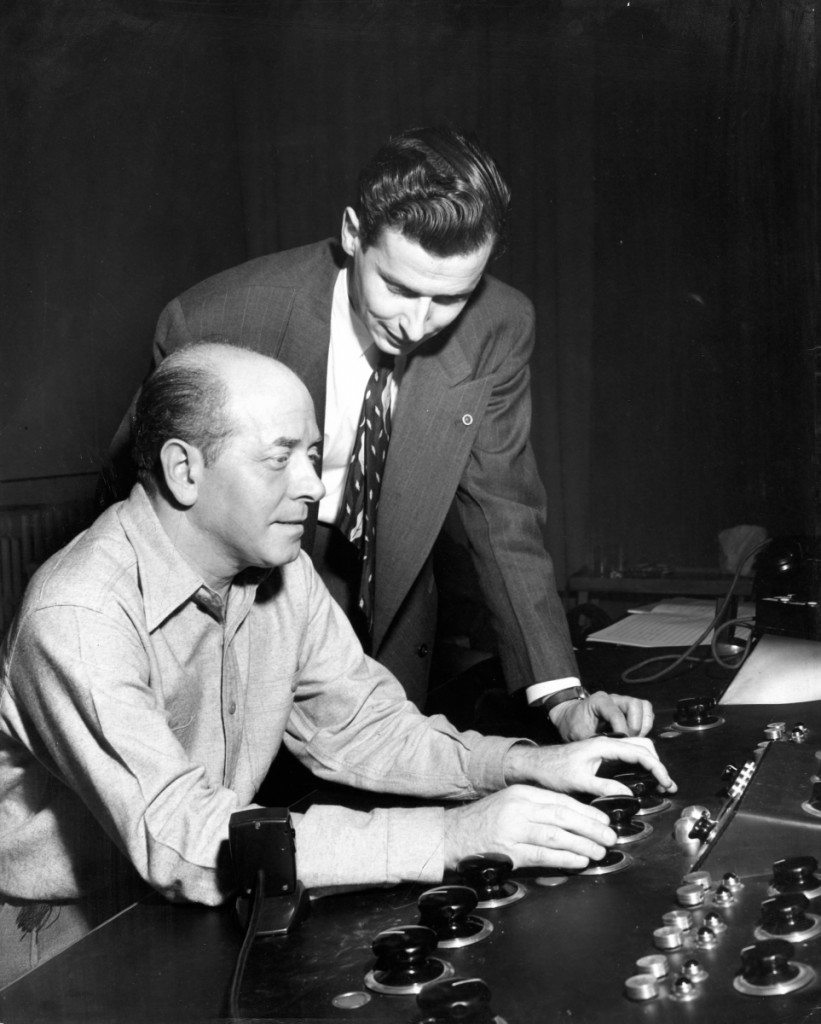 Above: Eugene Ormandy (L) and Bob Fine (R) work the Davens at RSS in 1948 (source: T. Fine)
Above: Eugene Ormandy (L) and Bob Fine (R) work the Davens at RSS in 1948 (source: T. Fine)
T. Fine: “During the time my father worked for Hazard “Buzz” Reeves in the late 40s, he engineered jazz and classical records for Mercury and Norman Granz (who later founded Verve Records). Among the significant jazz recordings were “Charlie Parker with Strings,” some sides in Granz’s deluxe “The Jazz Scene” album, and Charlie Parker’s latin-jazz sides with Machito on Mercury. Among the classical recordings for Mercury was the first U.S. use of the Neumann U-47 mic for orchestral recording: William Schuman’s “Judith” and “Undertow” performed by the Louisville Orchestra with Robert Whitney and William Schuman conducting.
“Here is a cut from the “Charlie Parker with Strings” sessions, followed by Charlie Parker with Machito and his Orchestra.
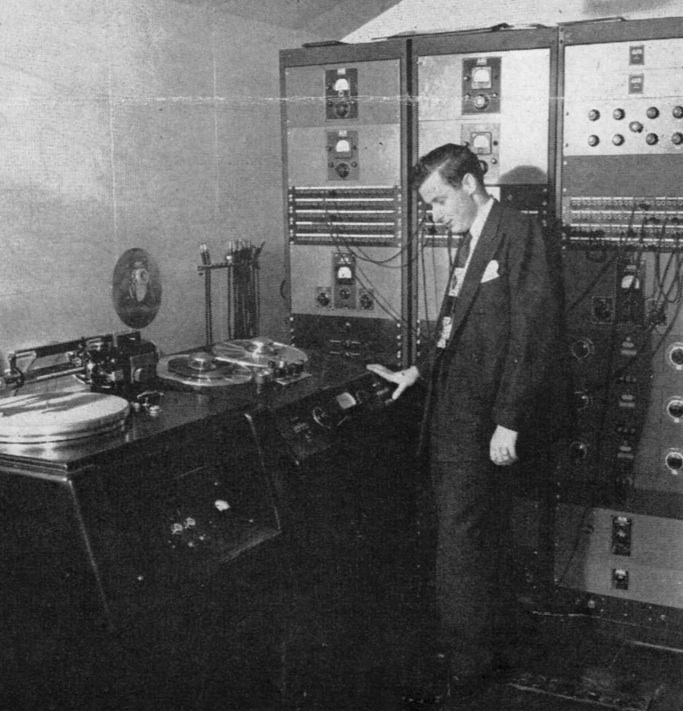 Above: Bob Fine in the Reeves A cutting room, 1949.
Above: Bob Fine in the Reeves A cutting room, 1949.
Ed: Bob Fine would leave RSS in the early 1950s to build his own sound studio Fine Sound, which was purchased and then closed by Loews/MGM. In 1958, Bob Fine opened Fine Recording Studios on 57th Street. You can read our account of Fine Recording Studios here and here.
T. Fine: “In the 50s, Reeves was the studio for a bunch of significant Riverside Records jazz recordings.
In a 2007 interview, Riverside founder/producer Orrin Keepnews (who’s still alive and in his 90s) talked about making a deal with Buzz Reeves to get the studio and engineer overnight at a cut rate if he block-booked chunks of days.”
“Not long after (1954), we made a long-term deal for a studio that was of great value to us.. (We) had become aware of Reeves Sound Studios in the East 40s. It was a big room—although easily brought down by screens and baffles to the small-group size we basically needed. The studio was used primarily for radio jingles and other advertising agency work. That meant it was rarely in use after daytime working hours. They agreed to give us almost unlimited time for a very low annual flat fee, provided our recording was basically done at night. It was a real meeting of needs. That low studio rate, and the quite reasonable union scale rates in that far-off deflationary period, made it possible for us to do a lot of recording with very little cash, which was a pretty essential factor in the early growth of Riverside.” (source)
T. Fine: “It was perfect for jazz because Keepnews would have the guys come by to record after their club dates. He got a more relaxed but still tight feel than some of the Blue Note and Prestige sessions at Van Gelder, where the guys would often show up in daytime hours, off-kilter from their night-owl schedules.
“Reeves figured so prominantly in Riverside’s viability that some first-edition Riverside LP covers included a little graphic on the front boasting of “Riverside Reeves Spectrosonic High-Fidelity Engineering.” In the early stereo era, the “Stereosonic” replaced “Spectrosonic” in the logo.
“According to the Riverside Records discography located here, the sessions at Reeves began in late 1955 and continued until 1961.
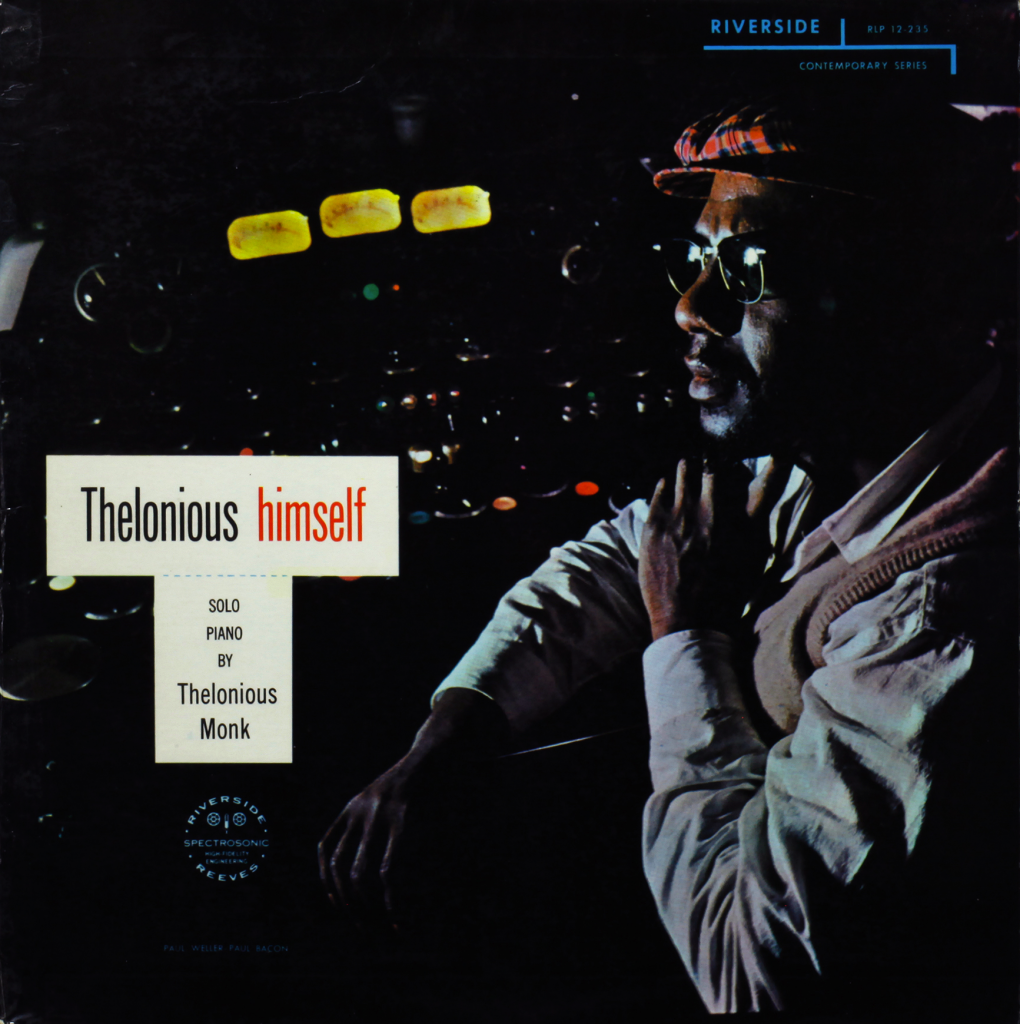 (SOURCE)
(SOURCE)
*********
***
T. Fine: “In the 60s, Reeves turned more to sound-for-picture work, and they were an early TV-sound production center in NY. They later did a lot of sound mixing for videotaped productions, especially with WNET Public TV. Reeves bought out Fine Recording in the early 70s, and Bob Fine then managed Reeves Cinetel Studios in the early 70s. One of the projects he worked on then was producing the sync’d sound masters for the simulcasts of Don Kirschner’s “In Concert” late-night weekly rock concert series.”
“RSS produced a 4-track 1/2″ tape that was sync’d to video by a 59.95 Hz signal on one track, stereo audio (fed to the simulcasting FM station) on two tracks and mono audio to feed the TV station audio (or mono radio) on the 4th track.”
*********
***
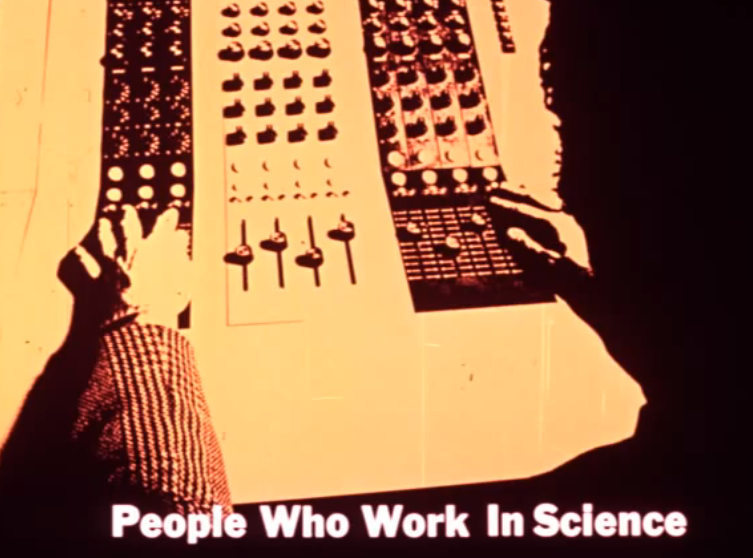 T. Fine: “In 1972, Guidance Associates (still in business in Mt. Kisco NY) produced a filmstrip centered around RSS sound engineer Bill Brueckner. Bill’s work day described in the filmstrip involved putting the soundtrack together for a Cheetos TV commercial. The filmstrip shows images of a 1970’s sound-for-picture studio in action. Brueckner is shown working in two separate studios at Reeves. The studio where the commercial was made was the more modern studio. The console appears to be custom-made, probably using Langevin faders and internal parts. The second studio shown, where Brueckner is recording a voice-over later in the filmstrip, is older. Visible there are a Fairchild full-track tape machine, an Ampex 300 full-track, plus a very old mono console.”
T. Fine: “In 1972, Guidance Associates (still in business in Mt. Kisco NY) produced a filmstrip centered around RSS sound engineer Bill Brueckner. Bill’s work day described in the filmstrip involved putting the soundtrack together for a Cheetos TV commercial. The filmstrip shows images of a 1970’s sound-for-picture studio in action. Brueckner is shown working in two separate studios at Reeves. The studio where the commercial was made was the more modern studio. The console appears to be custom-made, probably using Langevin faders and internal parts. The second studio shown, where Brueckner is recording a voice-over later in the filmstrip, is older. Visible there are a Fairchild full-track tape machine, an Ampex 300 full-track, plus a very old mono console.”
T. Fine: “The filmstrip (with accompanying LP) was part of a set titled “People Who Work In Science,” probably aimed at middle school aged kids. I found a mint-condition copy about 10 years ago; I assume a set was sent to my father since the ‘Sound Engineer’ strip was done at Reeves. I immediately transferred the LP, and eventually found someone to scan the filmstrip for me. Bill Wray, head of the AES Historical Committee and a retired Dolby exec, married the sound to the picture. He started out with side A of the LP, which has mid-range pitch manual-advance tones. He assembled the piece in Final Cut Pro and then laid over the side B audio, which had low-frequency auto-advance tones which I had notched out. We just recently finished it, got permission from the original publisher and posted it to the AES’ YouTube page. Thanks to Peter Haas for scanning the filmstrip and Jay McKnight for doing very good Photoshop cleanup on the images (the filmstrips were manufactured on that type of film stock that fades out to red over time).”
*************
*******
***
And that’s pretty much all I have been able to uncover regarding Reeves Sound Studios. Hazard Reeves himself was a very public figure with a great number of technologies and awards to his credit; he started sixty companies in his lifetime, won an Oscar, helped introduce the blender to American kitchens, and owned a major audio-tape manufacturing facility just a stones-throw away from where I grew up in Danbury Connecticut.
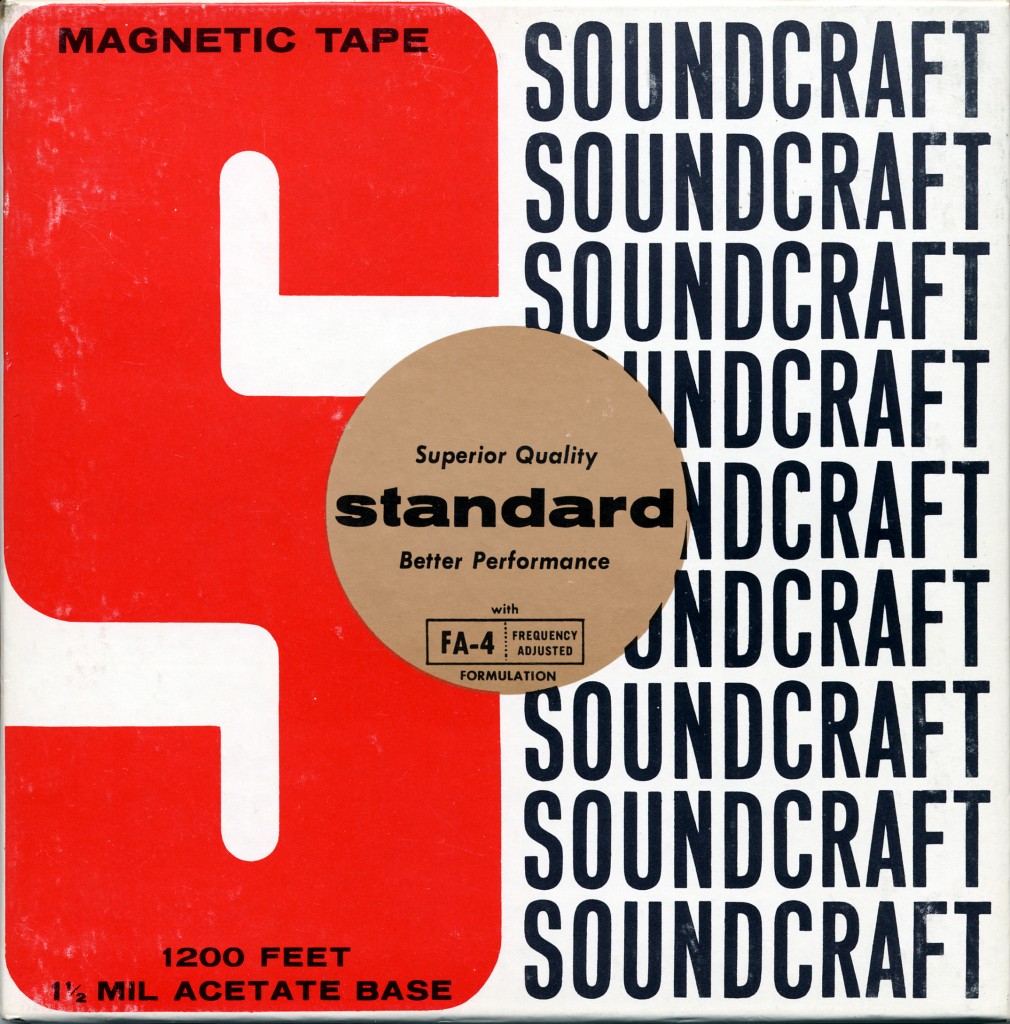 Above: a 7″ reel of consumer-grade Reeves Soundcraft audiotape, manufactured on Great Pasture road in Danbury CT.
Above: a 7″ reel of consumer-grade Reeves Soundcraft audiotape, manufactured on Great Pasture road in Danbury CT.
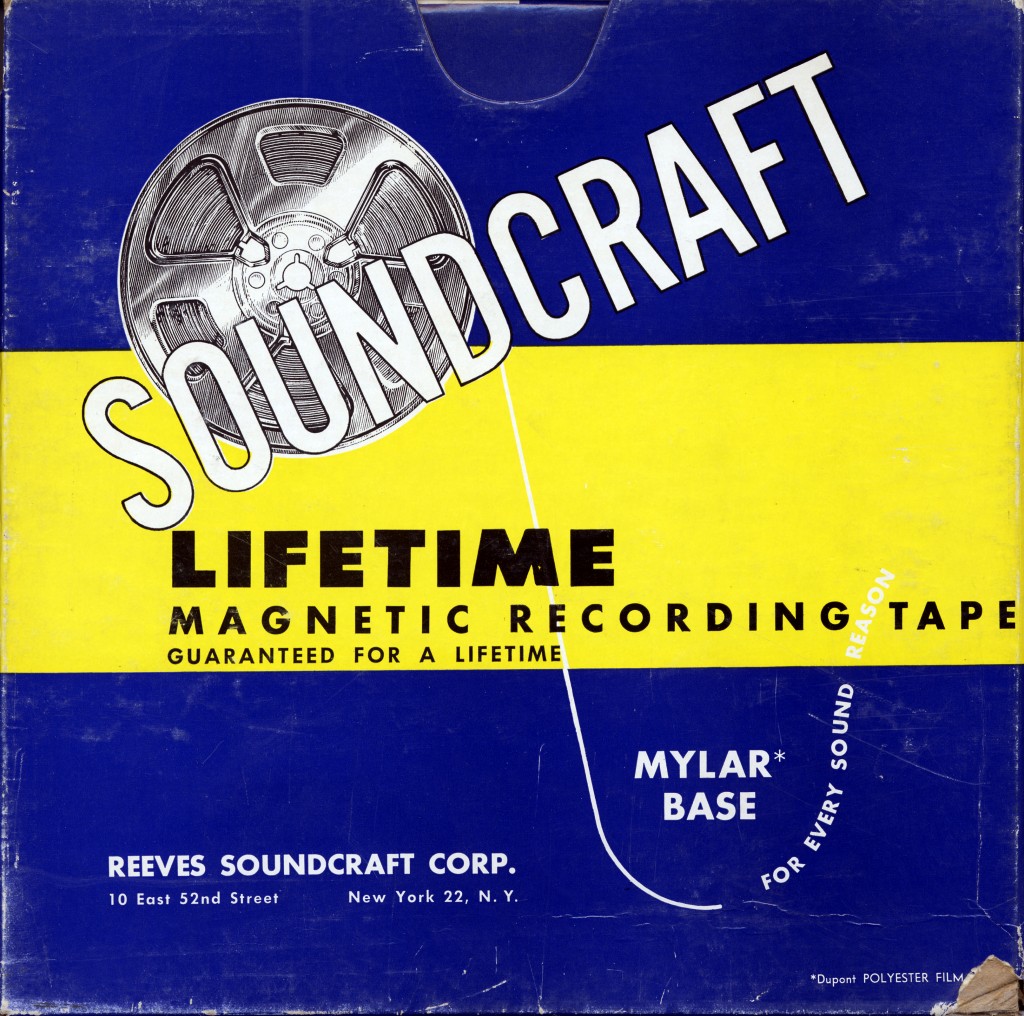
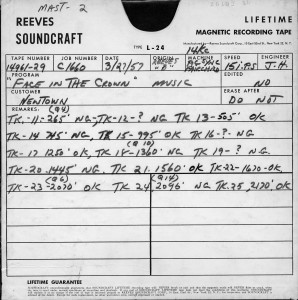 Above and left: a 10″ reel of industrial-grade Reeves audiotape. T. Fine: “Interesting data on the rear of the box. This was sound-for-picture music work done at Reeves Studio B. The engineer was “J.H.”, most likely Jack Higgins, the engineer who made most of the Riverside jazz records at Reeves. You see notes for “Pic-Sync Fairchild,” meaning the tape was recorded on one of the studio’s Fairchild tape machines using the Pic-Sync system, which used a tone modulated at 14kHz to sync with motion-picture cameras and projectors. I can’t fully interpret the take sheet, but it looks like they were scoring to picture, with timing marks indicating footage from the film projector.”
Above and left: a 10″ reel of industrial-grade Reeves audiotape. T. Fine: “Interesting data on the rear of the box. This was sound-for-picture music work done at Reeves Studio B. The engineer was “J.H.”, most likely Jack Higgins, the engineer who made most of the Riverside jazz records at Reeves. You see notes for “Pic-Sync Fairchild,” meaning the tape was recorded on one of the studio’s Fairchild tape machines using the Pic-Sync system, which used a tone modulated at 14kHz to sync with motion-picture cameras and projectors. I can’t fully interpret the take sheet, but it looks like they were scoring to picture, with timing marks indicating footage from the film projector.”
*********
***
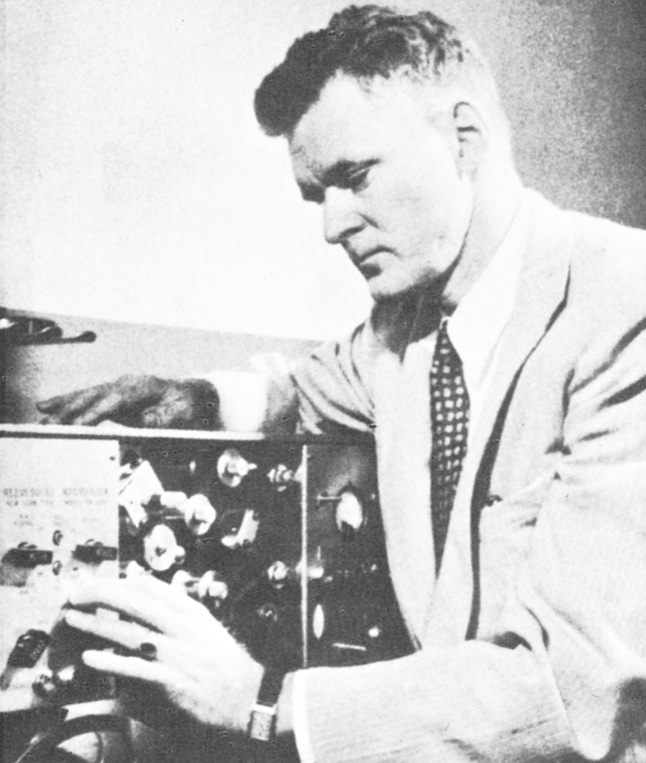 Above: Hazard Reeves with a Cinerama 6-channel sound-head circa 1948
Above: Hazard Reeves with a Cinerama 6-channel sound-head circa 1948
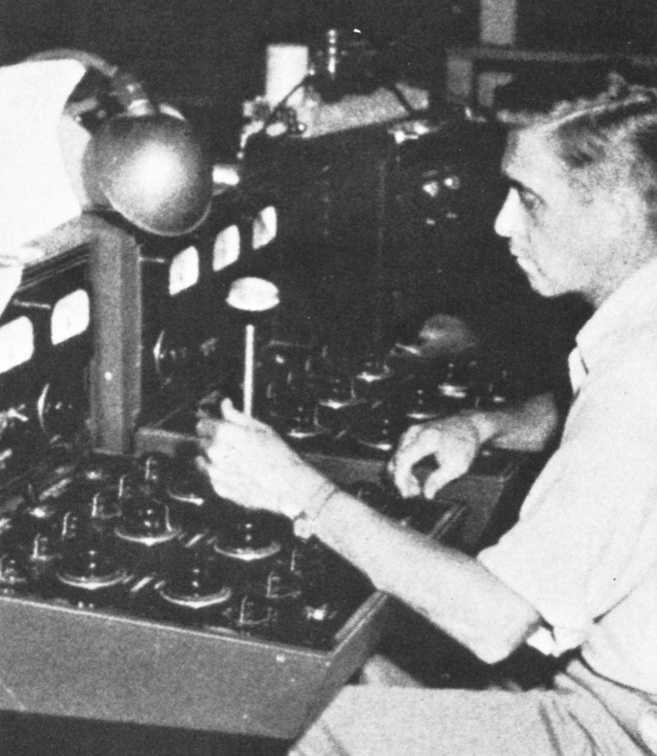 Above: an unknown audio engineer operates the 6-channel playback console at a Cinerama movie theater circa 1952.
Above: an unknown audio engineer operates the 6-channel playback console at a Cinerama movie theater circa 1952.
The 3-camera, 3-projector, 6-channel surround-sound film format known as Cinerama has proven to be Hazard Reeves’ principal legacy. There is a ton of information online regarding this far-ahead-of-its-time quirk of film history, so I won’t repeat any of that here. But I would like to point out how interesting it is that although Reeves possessed the technology to create 6-track magnetic audio masters as early as 1948 (as evinced by the image above), he did not chose to apply this technology to music recording. We can only assume that this was because the musical aesthetics of the day simply did not require it. In 1948, live music was still the paradigm of musical-sound; there was evidently not sufficient demand to build a console and studio workflow that would allow for multitracking and overdubbing until a decade later, ever though the actual recording technology evidently existed. This begs the question of what technologies we currently posses that could be put to the service of creating entirely new musical aesthetics, but which we are dismissive of, or simply blind to.
Nonetheless, Reeves’ diversified and energetic ventures reveal a man who boldly took advantage of the emerging technologies of his era to develop better and more effective communication products. Reeve’s assessment of the relation between media form and media message is stated quite eloquently in this passage he wrote in the November 1982 SMPTE Journal:
Show, don’t tell. That’s the message here. And ultimately this is remains the critical factor in creating meaningful artwork and communication, regardless of the tools and technologies used to produce it.
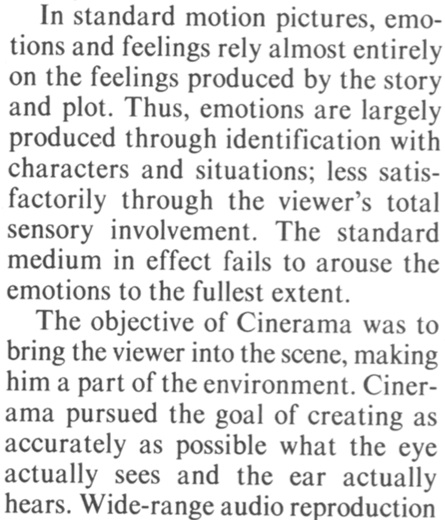
39 replies on “Reeves Sound Studios NYC (1933 – 197X)”
The film industry has always led the way with audio production techniques. You would be hard pressed to find anything “new” that hadn’t been done since the early ’30s in the film biz and in many cases radio drama.
Hi Chris:
Another excellent job putting together a history page. We focused on Hazard Reeves’ achievements in audio and film. Some readers might be interested in his extensive Ham Radio activities. These links are good places to start:
http://oldqslcards.com/K2GL.pdf
http://www.shermanbanks.net/Mary_and_Sherman_Web_Site/Vintage_Photos/Pages/1987_Buzz_Reeves_Estate.html
http://sportsillustrated.cnn.com/vault/article/magazine/MAG1002473/3/index.htm
(what a great time in America — where ham radio DX competitions were covered in Sports Illustrated!)
— Tom Fine
Hi Tom, Knew your father during his Reeves Sound Studios “second coming,” from 1968 thru mid 70’s. GREAT MAN IN EVERY WAY!
Buzz was a Georgia Tech grad (which is where the nickname came from) and he willed all of his ham radio gear to W4AQL, the Georgia Tech ham radio club, on his death. I remember a bunch of kids getting a van and driving it from Atlanta to New York in maybe the spring of 1985 and coming back with stacks and stacks of radio gear that they were still sorting through years later. I had never met him and at the time I had no idea who he was and I wish I’d had the chance.
Beautiful page! I’d love to know more about the tape manufacturing plant, though, and how that started up, because that was again one of the very first in the industry. And, it spawned a number of smaller tape manufacturers in Danbury like Sun-Mark and Socatone.
In Audio Engineering Jan 1954 there was an ad for a “S-T Condenser Microphone CM-51.” Schoeps, natch, precursor of the 201. It was being sold by Reeves Equipment Corp, NY, NY. Was Reeves the importer at that time? Was he distributing other OEM European gear?
Note: Picture of audio engineer at a six channel console after the shot of Hazard is not a theater playback system but the portable recording console for Cinerama location recording.
The “unknown engineer” very likely is Dick Voresek who I believe ran Reeves Sound NYC for many years.
I have a Reeves Telecom Associates certificate and am trying to find a company associated with it so that I can sell the units. Help!
I worked for “Buzz” from 1965 to 1995 at Reeves Video on 44st. I visited his home and ham radio stations twice. For what ever reason, I did not take any photos….Very happy to see some photos in the site. Someone did make a VHS of the ham radio setup. Any idea where that VHS is today???
Hi David, I worked with Phil Mancino at Reeves Sound 68-70! I have a couple of kinscopes of some of your work with the video swithers and some promotion Reeves Video Sevices stuff! I also have some still photos I shot of the facility and promotion booklets about the 3M laser film recorder that Bob Fine had hopes on while he was the acting president of the Reeves facility. As time went by I founded Nation Video Center and MTI which still operates as TV studios managed by NEP! Also, Phil and I purchased the upper east side Manhatten Pathe Studios which we converted into business office space with now only one studio still operating. This studio was the home of the Today Show when NBC was converting Rock Center radio studios for TV.
Hay Bob,
Hay Jim, What brought you to this Reeves website?
I worked at this facility in the 70’s and 80’s at Sound Shop. In 1986 my company bought several of the studios, dismantled them, and moved the equipment to North Carolina.
Chris:
Another great piece of recording history! Kudos to your efforts at bringing all this disparate bit of information together. Thanks also to Tom Fine for his generous contributions.
Keep up the great work!
Scott D. Smith CAS
I am looking for a picture of a device that Reevesound built for the 1950’s paging industry. It was used to broadcast users paging numbers. It was a short length of pre recorded 16 mm film on a holder, that would be placed in a playback device that sent out / broadcast the pre recorded user number. I am looking for a picture and or a description of the device.
Hazard was a mentor to my Dad Bernard Olcott who received two charming letters from Hazard in the early 1950s. I would be thrilled to learn more about Hazard
[…] Keepnews booked several sessions in October 1956 at his favorite Reeves Sound Studios in NYC. The studio did mostly radio and jingles recording work during the day and Keepnews, closely watching the spending of his on-a-budget label, worked out an arrangement with the studio to record at night, after the musicians finished their gigs. The studio and the engineer on many of the Riverside records, Jack Higgins, produced some of the best sounding jazz records of the 50s, but unfortunately remain lesser known then their counterparts at Blue Note and Columbia. You can read more about the studio here: Reeves Sound Studios. […]
My father, Chuck Campbell, worked at Reeves as a sound engineer before and after WW2 into the 1970s. I visited the studio many times and met all dad’s colleagues mentioned here from Buzz Reeves on down. Most memorable was watching the recording session for Mulligan Meets Monk (Riverside), where I saw Monk discover the celeste in the studio. My mother, Ruth Campbell, painted the mural high up in the lobby back then. This is a terrific page, very nostalgic.
John Campbell
My Father, Paul Lo Presti worked at Reeves for many years when I was a child. Worked closely with my “Uncle Richie”, Dick Vorisek, as they were boyhood friends from the Bronx.
Does anyone remember him or worked with him? .
I believe he was a re-recording mixer and I too spend many happy days “going to work with Dad”. Took the train from Crestwood (NY).
I would love to hear from anyone who knew him.
Please email me.
Thank you.
I believe my Dad, Paul Lo Presti, did indeed work with a man named Chuck, whom I met on my visits to Reeves with Dad.
I may have even met you.
Please email me?
Hello, I just saw your message here. The Chuck was certainly my dad . I was about 16 back then and don’t remember anyone clearly other than Thelonius Monk and Gerry Mulligan. Good memory.
Hello!
I am from TN and recently came across a 33 1/3 rpm record from Reeves Sound Studio. It is “Lucille Ball and WM. Holden in Miss Grant Takes Richmond”. Does anyone know anything about this record or have any information? I love history and would love to know some more about it.
Thanks!
Trying to find out about a couple of Old LPs that were given to me. They appear to be some kind of singing audition from the 1940s? If anyone has info I would appreciate it!
The 1st says “Audition” Soundcraft Full spectrum Reeves soundcraft corp 10 east 52nd st New York 22 NY made in USA.
Then in pencil on the paper album cover it is written Nora Smith “O Bethlehem” and the other side “As Lately we watched”.
The Second on has the same label but written in is “How long o Lord” Cavalry Reformed Choir 12/47 , the other side says Still still with me. Then written in Pencil on the paper album cover Dorothy Garman. Any info is appreciated!
He started many companies.It was a way to beat taxes.By starting a company he was exempt from a tax .Then each new company transfered ownership of a product to Reeves. He was later charged with tax evasion . That is all I recall at this time.
[…] known then their counterparts at Blue Note and Columbia. You can read more about the studio here: Reeves Sound Studios. The studio had an interesting impact on Monk’s sessions for Brilliant Corners as it hosted a […]
Hello!
My name is Anita and I am from Serbia. I have found one record which is made in Reeves Soundcraft Corp. in 1959. The record is in bad condition. It has some white coat on it and I can not play it. On the record is writing says: “MJIGOSH SERBIAN CHURCH CHOIR”. I am not sure what that can mean. Maybe you have some records from that time and tell me what is on it? Is it worth it to repair a record, if that is possible? Please, contact me at my email if you have any info about the record. Thank you in advance and sorry for my bad English! 🙂
My father in law was JH. Jack Higgins a jazz agent and engineer from London UK, I think you mentioned him in the article above.
You may find more early information on the ‘classical’ side, as RSS made several of the recordings around 1934-36 for the New Music Quarterly magazine’s series of subscription discs. (Actually hardly ‘classical’ as it was all extremely modern music!) See, for instance, David Hall’s discography and short article from the ARSC Journal (vol. 16/1-2, 1984, pp.10-27):
http://www.arsc-audio.org/journals/v16/v16n1-2p10-27.pdf
In particular, that gives the RSS address as 1600 Broadway, NYC,
home also of Timely, Gamut/General, which may help…
Great work. It filled in a lot of gaps for me. I worked two summers at the Flaherty Study Centre near Brattleboro, Vermont. Louisiana Story was a significant film and one that changed how we see docs. I have the claim of finding the first film that Robert Flaherty shot in 1916 at the same location. It was my job to find all the nitrate film at the centre and determine the film that would be preserved for future viewing.
Although now mostly retired I worked as an Audio Post Production engineer. The centre was the Flaherty home. One interesting note, When the Von Trapp family first came to North America they stayed at the Flaherty home. I was able to listen to dozens of tapes recorded with them while in Vermont.
Hi, If anyone knows the widow of Brad Stewart she may have photos I took of 44th street facility from the basement lad to the top floor transmision room. All 35mm b&W TRI X and a set of 8X10 prints, pictures were for a audio convention.
Great article – I came to it from a Soundcraft Ad in a 1961 download of the Magnetic Film and Tape Recording Magazine where I noticed the famous Reeves name in the company details. I associate Reeves with early electo-mechanical devices such as analog computers (didn’t he help to pioneer this field at the Cyclone Project around 1950 for the US Navy in Manhattan with Harry Belock – later of Everest Records – as project director?) and business machines. So many technological advances came out of WWII not only radar of course- including the wide angle lenses later adapted for movie cameras such as the Todd AO process and I believe magnetic audio recording itself, the first Ampex decks being based on German (Nazi) captured machines. The acquisition of a reel to reel “hi fidelity” quarter inch tape recorder was a real status symbol in the late 1950s and 1960s!!!!!!! Their sound quality was very impressive too. Many thanks for this aptly named treasure trove of a website. David (London, UK)
Hi Reeves veterans and fans. I want to make sure you know about this followup Preservation Sound posting:
https://www.preservationsound.com/2018/09/reeves-sound-studio-television-operations-circa-1962/
— Tom Fine
I worked at Reeves/Teletape 1979-1986. Reeves had merged with independent television production company Teletape in the 1970’s, before I worked there. I was a video maintenance technician at R/T and worked in a shop that was at the back of the Sound Shop’s Studio C on the 3rd floor from 1979 to 1982. After that, I moved into operations, doing video control, assistant editing, and videotape operation, culminating in editing for R/T, both at the 304 E. 44th Street post facility and in their studios and on remotes. It was the early foundation of my experience in television operations.
After R/T closed in 1986, I took an editing position at Unitel Video, followed by Penn Studios and the Sally Jessy Raphael Show. When Sally was cancelled, I got to edit for NBC’s Today Show from 2003 to my retirement i. 2017. It was a helluva ride.
Hi, just want to thank Preservation Sound and anyone else involved for the photos documenting the “Louisiana Story” sessions. This session is of great interest to, among others, devotees of the legendary and enormously influential principal oboe Marcel Tabuteau and principal clarinetist Ralph McLane, both pictured in the full-orchestra shot (thereby establishing that McLane was indeed on the session, something your photos make amply clear). In fact, such followers (of which I am one) would be grateful for any other photos you might have. If you can, please post! And thanks to Reeves through its many incarnations for all your contributions to recording technology, and music history!
As described very well by filmmaker/historian Dave Strohmaier, the CINERAMA sound system constructed by Buzz Reeves had 7 audio channels, 5 in the front of the theater and 2 in the back, all recorded on a separate 8-track 35mm magnetic film running at 30 ips (one track was for sync signal). 70mm films have 6 channels of audio, and the other 35mm wide-screen processes use 3 or 4, including the MGM “Perspecta-Sound” format invented by Bob Fine.
While Reeves’ design, including 7.1 Discrete Surround Sound, may have been decades ahead of his time, his staggered-head 8-track format would have made multi-channel synchronized layering rather difficult for modern music producers, along with razor blade editing. Ampex’s in-line heads solved both problems.
Hazard was a GaTech grad and his 2nd son, Hazard (Hal) Jr was my fraternity big brother at GaTech. He was Student Body presdent his senior year, BMOC. A few years after I left the USMC, I moved to NYC, and Hal and I worked at his Dad’s real estate company, Previews. I then moved to the Sound Studios in sales where I remember the movie folks that trooped through, including Streisand, Paul Newman and Mel Brooks, many others. Dick Vorisek mixed post production sound for The Twelve Chairs for Brooks, and each day’s session was a comedy. Dick was very talented; Nominated for an Oscar for “Reds”, mixed “Midnight Cowboy” and 125+ other movies. When Hazard bought Video Tape Center with the idea he could mix and edit video as he had been doing for years with sound, I moved to Reeves Video reporting to Bob Byloff, a really smart MIT grad who colorized the NBC 30 Rock studio with RCA cameras, and that Hazard hired away and brought over. He was the technical mind behind getting into video tape. There were two video editing rooms in the east 44th Street sound building fitted with Ampex 2-in. color video machines at about 1,000 lbs each. Then Bob died from a heart attack at age 40, and I was named MD of Reeves Video. I reported to Chet Stewart. One of our salesmen had an acquaintance withJoan Ganz Cooney, and we got the studio contract to shoot the first 13 weeks of Sesame Street. Also did Hallmark Hall of Fame shoots, a Don Ho remote shoot in H! and many many commercials. I also worked with Brad Stewart. Creative processes like editing cannot be scheduled into close time blocks, yet editing was always booked by the hour. It therefore ran over much of the time and for long hours. I am not sure how the tech folks could continue that for years as they did. I burned out and moved to a NC production company in Jan 1971. Because of my relationship with Hal Reeves, I was in Hazard’s house in Tuxedo Park, NY; listened in on his amateur radio contacts; and ate at his restaurant, Duck Cedar. He as perhaps the smartest man I ever met.
Hi there — I’m inventorying some materials from the former Ampex museum and came across a Soundcraft-branded 10.5″ metal hub containing quite a lot of GREEN 2″ tape of some kind (it isn’t brown or red-brown or black like other magnetic tape in these boxes, it’s GREEN). — What is this? Thank you for your help! I’m not getting much help via the aes.org usual online sources.
My father, Thomas E Dillinger was a sound engineer at reeves in the 1960s. My grandfather may have worked there as well Alphonse Dillinger.